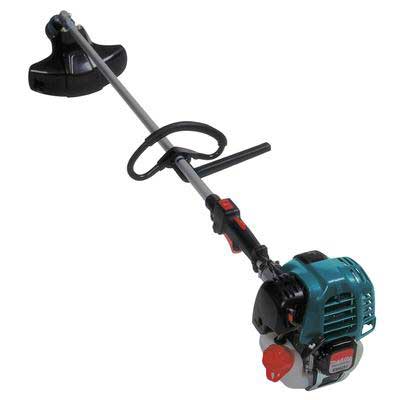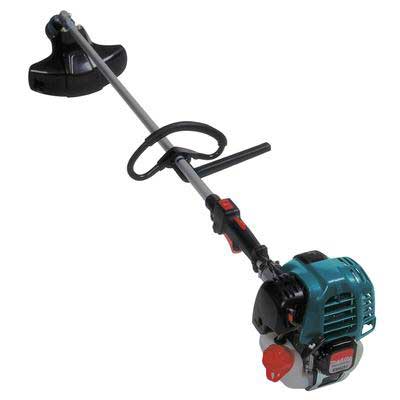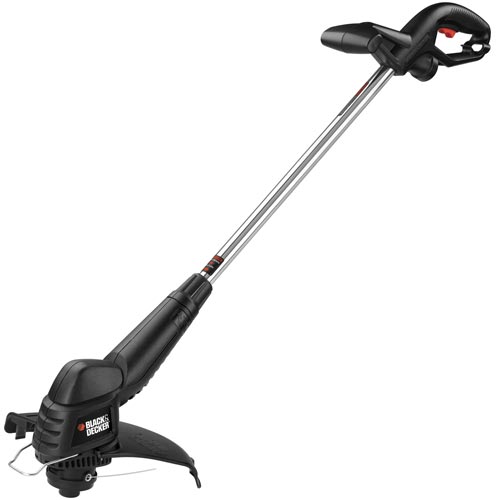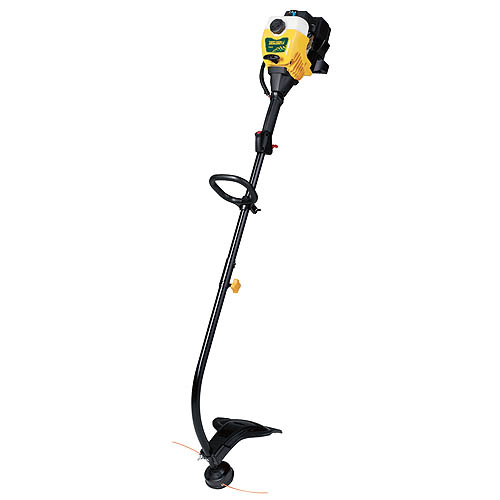Why Read This Article?
Finish Nailer Repair - Replacing the Driver Guide (Ridgid Part # 79004001022)
Article Breakdown
Finish Nailer Repair - Replacing the Driver Guide (Ridgid Part # 79004001022)
Safety Guidelines
- Safety eyewear should always be worn when operating any kind of trimmer.
- It is important to wear protective clothing when using trimmers.
- Protective earwear should be worn when operating a trimmer, as most trimmer use exceeds recommended decibels.
- Gloves should be worn to protect the hands from flying debris.

This article relays some helpful information about line trimmers and our purchasing suggestions for considering each trimmer type and feature. As always, making the right purchase is about weighing user needs, job demands, and budget against trimmer types, features, and costs.
Types of Line Trimmers
There are three major things that make one trimmer different from the next: 1) its method of power, 2) its line feed design, and 3) its shaft design. These three factors (along with feature options) can combine in almost any way to make a wide variety of garden trimmers suited for a wide variety of jobs and trimmer users. Each difference comes with its own list of pros and cons, making it easy to mix and match options until the right trimmer is found. Because powering method is usually the most dividing factor, we'll start there.
Power Options
Trimmers are available in three different designs of power supply: electric, gas, and propane. Power method will determine a trimmer's overall power, workload capacity, usability, and environmental impact.
Electric Trimmers:
In general, electric trimmers are light, user friendly, inexpensive, and can handle light to medium workloads. Electric trimmers are also much easier to start than gas trimmers. Both corded and battery-powered trimmers are available, and usually weight around 5 to10 pounds.
Corded Trimmers:
Dedicated electric trimmers are great for homeowners and most non-professional applications, because, unless the power of a gas trimmer is needed, a corded trimmer will get the job done with less hassle and effort on the part of the user.
Electrically powering tools is a more environmentally-friendly option than gas powered tools.
Also, their electric starting systems start much easier than gas trimmer starters, giving them an advantage in usability. Corded electric trimmers are also the lightest and least expensive of them all, usually making them the most attractive choice when portability and increased power isn't a concern.
But those are the two trade-offs: portability and power. Although even mid-range corded electric trimmers can take care of moderate overgrowth and cut through some pretty thick yard situations, once you get into clearing brush, clearing woody plants, and very heavy use, stepping up to a gas-powered trimmer is necessary.
If a trimmer needs a long reach but doesn't have to be completely mobile, looking at the specs will help. Corded trimmers will have a cord length rating that indicates how long of an extension cord can be used with them. It's important to follow the guideline of this rating, because running too much cord can be dangerous (Power Cords).
The overall power of corded trimmers is expressed with an amperage rating, and are typically available in the 3 amp motor to the 7+ amp motor range.
Pros:
- They are quieter than gas-powered trimmers.
- Corded electric trimmers are the lightest.
- Corded electric trimmer motors do not require maintenance like gas motor trimmers.
- They can handle most light to medium workloads.
- Their electric starters start much easier than gas trimmer starters.
- More environmentally friendly than gas-powered trimmers.
- Corded trimmers are the least expensive of the three power types.
Cons:
- Corded electric trimmers usually can't handle heavy workloads.
- Dedicated trimmers lack the portability of gas, propane, and battery powered trimmers.
Corded Electric Trimmer Example: The Black & Decker ST4500
Cordless Trimmers:
Cordless electric trimmers are battery-powered. Although battery powered trimmers are conveniently portable, their disadvantages usually their advantage. The battery adds extra weight to the trimmer, it restricts use to its short battery life, and the battery must be recharged.
Many cordless trimmer users report batteries that only last twenty minutes but can take many hours to recharge. The batteries are sometimes inseparable from the trimmer, making the trimmer unusable while recharging. Generally, cordless trimmers are also the least powerful trimmers.
Reviews and opinions on cordless trimmers can vary drastically, but more often than not, the general idea is go for a light gas trimmer if an electric cordless is starting to look good. However, some users report good experiences with certain models, so doing a little extra research on specific trimmers is probably best.
Like other battery operated tools, the overall power of cordless trimmers is expressed by the voltage of the battery. Most cordless line trimmers come in the range between 12v and 36v.
Pros:
- They are quieter than gas-powered trimmers.
- Cordless electric trimmers combine the eco-friendly power of
- electricity with the portability of gas-powered trimmers.
- They are less expensive than gas trimmers.
Cons:
Again, specific research on cordless electric trimmers might be the best way to address their pros and cons. [Back to top]
- Generally speaking, cordless electric trimmers are the lowest power trimmers.
- Cordless trimmer batteries tend to have very short use life.
- Their batteries also tend to take a long time to charge.
- The addition of the battery adds weight to the unit.
Gas Trimmers:
In general, gas powered trimmers are louder, heavier, more expensive, require more maintenance than electric trimmers, and are less eco-friendly than electric trimmers. Gasoline trimmer's redeeming quality is the combination of portability and high power that electric trimmers lack.
There's no getting around choosing a gas trimmer when heavy work needs to be done. Brush cutting, woody plants, and frequent trimmer use all call for the power of a gas trimmer. The good news is that competitively priced gas trimmers are available that can handle most heavy loads, although they will be more expensive on average than electric trimmers.
There are two major engine designs for gas powered trimmers: 2-stroke engines and 4-stroke engines.
Because the above section on electric trimmers compares gas and electric trimmers, the below pros and cons will only compare between 2 and 4-stroke gas trimmers. Gas trimmers normally weigh between about 9 and 15 pounds. Their overall power is measured by engine size in cc, usually in the 20 cc to 32 cc range.
2-Stroke:
2-stroke engines are the older of the two styles, but only offer one advantage over 4-stroke engines, less cost. They require a fuel/oil mixture instead of pure gasoline, they pollute more, are louder, are less powerful, and generally run less smoothly than 4-stroke trimmers.
Pros:
- They are less expensive than 4-stroke line trimmers.
Cons:
- 2-stroke trimmers are louder.
- They require a gas/oil mixture.
- They are more damaging to the environment than 4-stroketrimmers.
- 2-stroke trimmers are less powerful than 4-strokes and generally don't run as well.
4-Stroke:
The only real drawback to 4-stroke trimmers is their extra cost, but the benefits are almost always worth it if the power of a gas trimmer is needed. More and more gas trimmers are being designed with 4-stroke engines because of pressure to meet environmental standards, so we can probably expect 2-stroke trimmers to eventually be weeded out.
Pros:
- 4-stroke trimmers are quieter than 2-stroke trimmers.
- They do not require a gas/oil mixture.
- They are more eco-friendly than 2-stroke trimmers.
- They are the most powerful of all trimmers.
Cons:
- 4-stroke gas line trimmers are the most expensive, but they are the best choice for heavy and very heavy work, like brush clearing.
Gasoline Trimmer Example: The Makita EM4251 4-Stroke Gas Trimmer
 [Back to top]
Propane Trimmers:
[Back to top]
Propane Trimmers:
Propane trimmers are available as a gas-powered, eco-friendly alternative to gasoline trimmers. Propane is much less damaging to the environment than gasoline, and, being a gas powered, propane trimmers can match the heavy duty work that gasoline trimmers do.
But there are some drawbacks to propane trimmers. Propane canisters must be purchased to operate them, and are usually not refillable. Also, the canisters have to be disposed of correctly, adding some additional hassle. Propane trimmers are also just as pricey as 4-stroke gasoline trimmers.
Pros:
Eco-friendly, powerful alternative to gasoline trimmers.
Cons:
- They require the purchase of propane canisters.
- The canisters add weight to the machine.
- Propane canisters must be disposed of carefully.
- There is no cost advantage to buying a propane trimmer over a gasoline trimmer.
In bump feed systems, long lengths of line are wound around the spool of the trimmer until needed. Bump feed line advancement systems work by bumping or tapping the bottom of the trimmer to the ground as the trimmer is running. This depresses a spring system that releases a small length of line through the line outlets. Bump feeds are simple, dependable, and tend to be the recommended feed system by trimmer users.
Again, because so much diversity exists even within different bump feed designs, looking through product reviews on specific models is a good idea. Fixed Head:
In fixed head systems, individual lengths of line are loaded into the trimmer one at a time as needed. This design avoids some of the hassle of spooling line onto trimmers, and makes the overall process of dealing with trimmer line less complicated. However, this means that the trimmer must be stopped each time line needs to be replaced.
Because of this, fixed head systems tend to be more popular with larger trimmers that use, thicker, tougher string. The tougher line decreases wear and breaks, making the breaks between work to reload the trimmer fewer and farther between.
It seems that everyone has an opinion on fixed head systems too, so browsing some reviews and forums on specific trimmer models can do a lot of good. Automatic Feed:
Several trimmers are designed with automatic feed systems. Auto feed systems use line spooling, like bump feed systems, but nothing is required on the part of the user to advance the line.
Auto feed designs get mixed reviews from brand to brand, model to model. Most of the major problems encountered with auto feed systems result because of bad line spooling, or simply because of poor design; however, some systems and models with auto feed are rated well.
Because of this uncertainty, it's usually best to default to the more dependable bump feed system, unless automatic line feeding is really needed (which may be the case for some users). In that case, checking individual reviews and user feedback will go a long way. [Back to top] Shaft Design There are three major shaft designs for garden trimmers, and each affects the usability of the tool in different ways. The three designs are: curved shaft, straight shaft, and split shaft. Although there are specific pros and cons for each design, choosing between them usually comes down to how the trimmer feels in the user's hands, a matter of personal preference. Curved Shaft:
This design provides the most comfort for trimmer users, especially when "mowing" at ground level. Although the curved shaft allows trimmer users to assume a comfortable standing posture, the design is just a little limited when it comes to trimming far underneath shrubs, bushes and other obstacles. Also, a curved can limit a trimmer's power, but this only becomes an issue when dealing with very heavy duty machines.
Curved shaft designs tend to be the choice of homeowners and trimmer users concerned with posture fatigue.
Pros:
- Comfortable usability.
Cons:
- Can be a power-limiting design, but not always.
- Shorter reach for getting under shrubs and bushes.
Curved Shaft Trimmer Example: The Yard Man YM20CS Curved Shaft Trimmer
Some users like the traditional straight shaft trimmer design best. Like with curved shaft trimmers, it's really just a matter of preference. However, straight shaft designs offer more reach for trimming underneath obstacles. Most of the more powerful trimmers use a straight shaft design.
Straight shaft designs tend to be the choice of professional landscapers and trimmer users who expect heavy work.
Pros:
- Straight shaft design never limits trimmer power.
- Straight shaft design offers better reach under obstacles.
Cons:
- Less comfortable usability for some users.
Straight Shaft Trimmer Example: The Weed Eater XT700 Straight Shaft Trimmer
Split shaft design trimmers allow the end of the trimmer shaft to be separated from the rest, so that additional tool attachments can be fitted to the trimmer (such as leaf blowers and edgers), making the unit an "all around" tool.
The use of attachments on a trimmer is the only advantage to a split shaft, so they should only be considered when additional trimmer attachments are needed.
Pros:
- Split shaft designs allow for adaptability of other tool attachments to a trimmer.
Cons:
- Additional cost for additional features, but not really a "con" if the additional features are needed.
Rotating Head-
Rotating head features allow a trimmer head to be turned to a 90? angle for edging tight areas, and some trimmers come with additional features (like wheel systems) to further improve how they edge.
It's important to keep in mind that most trimmers won't be up to edging near sidewalks and other hard surface, since contacting them can quickly wear or break trimmer line.
Looking at each model on a case by case basis will determine whether or not a rotating head feature is right.
Carrying Aids-
Straps and other supports are available for heavier trimmers in a variety of styles.
Top Mounted
Motors-
Some electric trimmers mount their motors at the working end of the trimmer, with the bell. This causes balance issues with the tool.
Top mounted trimmers are always balanced better, so choosing a top mount design for electric trimmers is always best. Gasoline powered trimmers always mount their trimmers on top for better balance.
Rapid Loaders-
Several trimmer brands now offer rapid loading designs to make re-spooling trimmers easier.
Reviews for most of these systems are very favorable, so if spooling trimmer line is a big headache for a user, looking into rapid loading trimmers can save a lot of time and frustration down the road.
Blades and
Other Accessories-
String and line trimmers can often be upgraded with blade accessories for heavy cutting. This is especially true of gasoline trimmers.
Trimmers can also include other cutting accessories with purchase, especially those with a split shaft design. Gasoline trimmers tend to have the most upgrade options, since they handle the heavier workloads where the options apply. [Back to top] Features for Gas Trimmers:
Centrifugal
Clutch-
A centrifugal clutch will allow a gas trimmer to idle without spinning. This is an important safety feature, and might require a little additional research when shopping around.
Clear Fuel
Tank-
Sounds simple, but the fuel tanks on some gas trimmers aren't translucent, making it difficult to determine the fuel level. Most users will appreciate having clear gas tank.
Spring-Assist
Starting-
Start assist systems are available for some gas trimmers, making them easier to start up.
Exhaust
Deflector-
Like the name suggests, exhaust deflectors divert the exhaust produced by gas trimmers. Buying a trimmer with an exhaust deflector is very important for left-handers, who will get blasted with exhaust without one. [Back to top] Trimmer Line:
Each trimmer will be rated for a specific size (or size range) of trimmer line (string). Garden trimmer line is measured by its diameter in inches (in America), ranging from 0.065 in. to as thick as 0.170 in. The thickness of line should be determined by the trimmer's specifications and the type of work it is doing. Roughly,
For light-medium work: 0.065 in. - 0.085 in.
For medium-heavy work: 0.085 in. - 0.110 in.
For very heavy work: 0.110+
Most trimmer line is made of a simple nylon or monofilament fiber material, but there are many other kinds that infuse other harder materials (like metals) into the fiber to make them more durable.
Trimmer lines also come in different shapes, such as round, twisted, square, and five-sided (star). Shapes with edges, like square and star shaped lines, add more cutting power to the line and help reduce snagging for clearing denser material.
Cutting Path:
The cutting path for a line trimmer is the diameter of the area that the cutting line(s) cover. Cutting path is usually expressed in inches, and is also a good way to match a trimmer to its type of work (along with power type, feed design, and shaft style). Here is an approximate scale for matching cutting path to workload:
For very light work: 7" - 9"
For light-medium work: 10" - 14"
For medium-heavy work: 15" - 16"
For very heavy work: 17" and up
[Back to top]
Conclusion
Like with any tool or machine purchase, the more you know the better off you are. String and line trimmers come in all kinds of varieties and with all sorts of features, but these can be sorted out quickly when budget and job demands are carefully considered.
Like most power tools, a good trimmer that will keep cutting over the years will need maintenance and a new part here and there. Visit eReplacementParts.com's Trimmer Parts page to find the parts that will keep your string trimmer in the best condition possible.
[Back to top]
What we're about.





















































